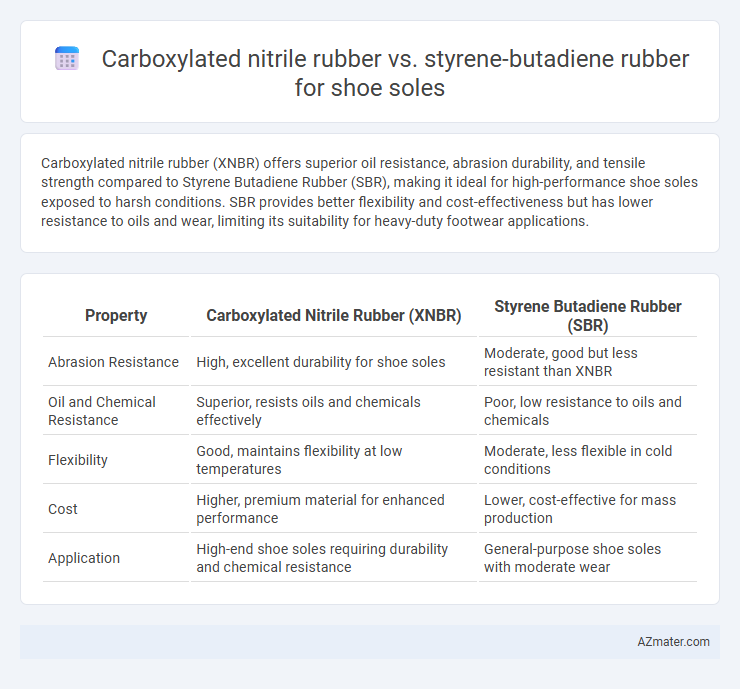Carboxylated nitrile rubber (XNBR) offers superior oil resistance, abrasion durability, and tensile strength compared to Styrene Butadiene Rubber (SBR), making it ideal for high-performance shoe soles exposed to harsh conditions. SBR provides better flexibility and cost-effectiveness but has lower resistance to oils and wear, limiting its suitability for heavy-duty footwear applications.
Table of Comparison
| Property | Carboxylated Nitrile Rubber (XNBR) | Styrene Butadiene Rubber (SBR) |
|---|---|---|
| Abrasion Resistance | High, excellent durability for shoe soles | Moderate, good but less resistant than XNBR |
| Oil and Chemical Resistance | Superior, resists oils and chemicals effectively | Poor, low resistance to oils and chemicals |
| Flexibility | Good, maintains flexibility at low temperatures | Moderate, less flexible in cold conditions |
| Cost | Higher, premium material for enhanced performance | Lower, cost-effective for mass production |
| Application | High-end shoe soles requiring durability and chemical resistance | General-purpose shoe soles with moderate wear |
Introduction to Shoe Sole Materials
Carboxylated nitrile rubber (XNBR) offers superior oil and abrasion resistance, essential for durable and long-lasting shoe soles used in industrial and outdoor environments. Styrene butadiene rubber (SBR) provides excellent flexibility and cost-effectiveness, making it a popular choice for casual footwear soles requiring comfort and moderate wear resistance. Each material's unique polymer structure influences traction, resilience, and environmental resistance, directly impacting shoe sole performance and longevity.
Overview of Carboxylated Nitrile Rubber (XNBR)
Carboxylated nitrile rubber (XNBR) is a specialty elastomer known for its enhanced oil resistance, high tensile strength, and improved abrasion resistance compared to traditional nitrile rubber, making it ideal for demanding shoe sole applications. XNBR's unique carboxyl groups enable superior crosslinking density, resulting in increased durability and resilience under mechanical stress and chemical exposure. Its blend of flexibility and toughness provides an excellent balance between comfort and long-lasting wear, setting it apart from styrene butadiene rubber (SBR), which is more prone to wear and less resistant to oils and solvents.
Overview of Styrene Butadiene Rubber (SBR)
Styrene Butadiene Rubber (SBR) is a synthetic rubber commonly used for shoe soles due to its excellent abrasion resistance, good aging stability, and cost-effectiveness. SBR provides superior durability and flexibility, making it ideal for high-wear areas and outdoor footwear applications. Its ability to maintain performance in various temperatures enhances the comfort and longevity of shoe soles compared to alternative materials.
Key Physical Properties: XNBR vs SBR
Carboxylated nitrile rubber (XNBR) offers superior abrasion resistance and tensile strength compared to styrene butadiene rubber (SBR), making it ideal for high-wear shoe soles. XNBR has enhanced oil and chemical resistance due to its carboxyl groups, providing better durability in harsh environments, whereas SBR exhibits good flexibility and impact resistance but lower resistance to oils and solvents. The higher hardness and improved tear resistance of XNBR result in longer-lasting shoe soles, particularly for industrial or heavy-duty applications.
Abrasion Resistance Comparison
Carboxylated nitrile rubber (XNBR) exhibits superior abrasion resistance compared to styrene butadiene rubber (SBR), making it ideal for high-performance shoe soles exposed to rough surfaces. XNBR's enhanced cross-linking density and stronger intermolecular forces contribute to its excellent durability and wear resistance under repeated friction. SBR, while cost-effective and flexible, tends to wear down faster, reducing the lifespan of shoe soles subjected to heavy abrasion.
Flexibility and Comfort in Footwear
Carboxylated nitrile rubber (XNBR) offers superior flexibility and enhanced abrasion resistance compared to styrene butadiene rubber (SBR), making it ideal for shoe soles requiring durability and comfort. XNBR exhibits better tensile strength and elasticity, providing improved shock absorption and foot cushioning, which contributes to prolonged comfort during wear. In contrast, SBR, although cost-effective and widely used, tends to have lower flexibility and may result in stiffer soles, potentially reducing overall comfort in footwear applications.
Oil and Chemical Resistance in Shoe Soles
Carboxylated nitrile rubber (XNBR) exhibits superior oil and chemical resistance compared to styrene butadiene rubber (SBR), making it ideal for shoe soles exposed to harsh environments. XNBR's enhanced polarity from carboxyl groups improves its resistance to fuels, oils, and various chemicals, extending sole durability and performance. In contrast, SBR offers moderate resistance but tends to degrade faster when in contact with oils and aggressive chemicals.
Cost and Manufacturing Considerations
Carboxylated nitrile rubber (XNBR) offers enhanced abrasion resistance and oil resistance compared to styrene butadiene rubber (SBR), making it suitable for high-performance shoe soles but at a higher material cost. SBR provides a cost-effective alternative with easier processing and faster curing times, reducing manufacturing expenses for mass production. Manufacturers must balance the superior durability and chemical resistance of XNBR against the affordability and production efficiency of SBR when selecting materials for shoe soles.
Environmental Impact and Sustainability
Carboxylated nitrile rubber (XNBR) offers enhanced resistance to oils and chemicals, contributing to longer shoe sole lifespan and reduced material waste compared to styrene butadiene rubber (SBR), which tends to degrade faster. XNBR production involves partially synthetic processes with moderate environmental impact, while SBR relies heavily on petrochemicals with higher carbon emissions and greater environmental burden. Recyclability of XNBR shoe soles is more efficient due to crosslinking properties, promoting sustainability through material recovery and reducing landfill accumulation relative to SBR-based soles.
Conclusion: Selecting the Optimal Rubber for Shoe Soles
Carboxylated nitrile rubber (XNBR) offers superior abrasion resistance, chemical stability, and flexibility compared to styrene butadiene rubber (SBR), making it ideal for high-performance shoe soles exposed to harsh conditions. SBR provides cost-effectiveness and good aging resistance but lacks the enhanced oil resistance and durability of XNBR, limiting its use in demanding environments. Selecting XNBR ensures longer-lasting, more resilient shoe soles, while SBR suits budget-conscious applications with moderate wear requirements.

Infographic: Carboxylated nitrile rubber vs Styrene butadiene rubber for Shoe sole
 azmater.com
azmater.com